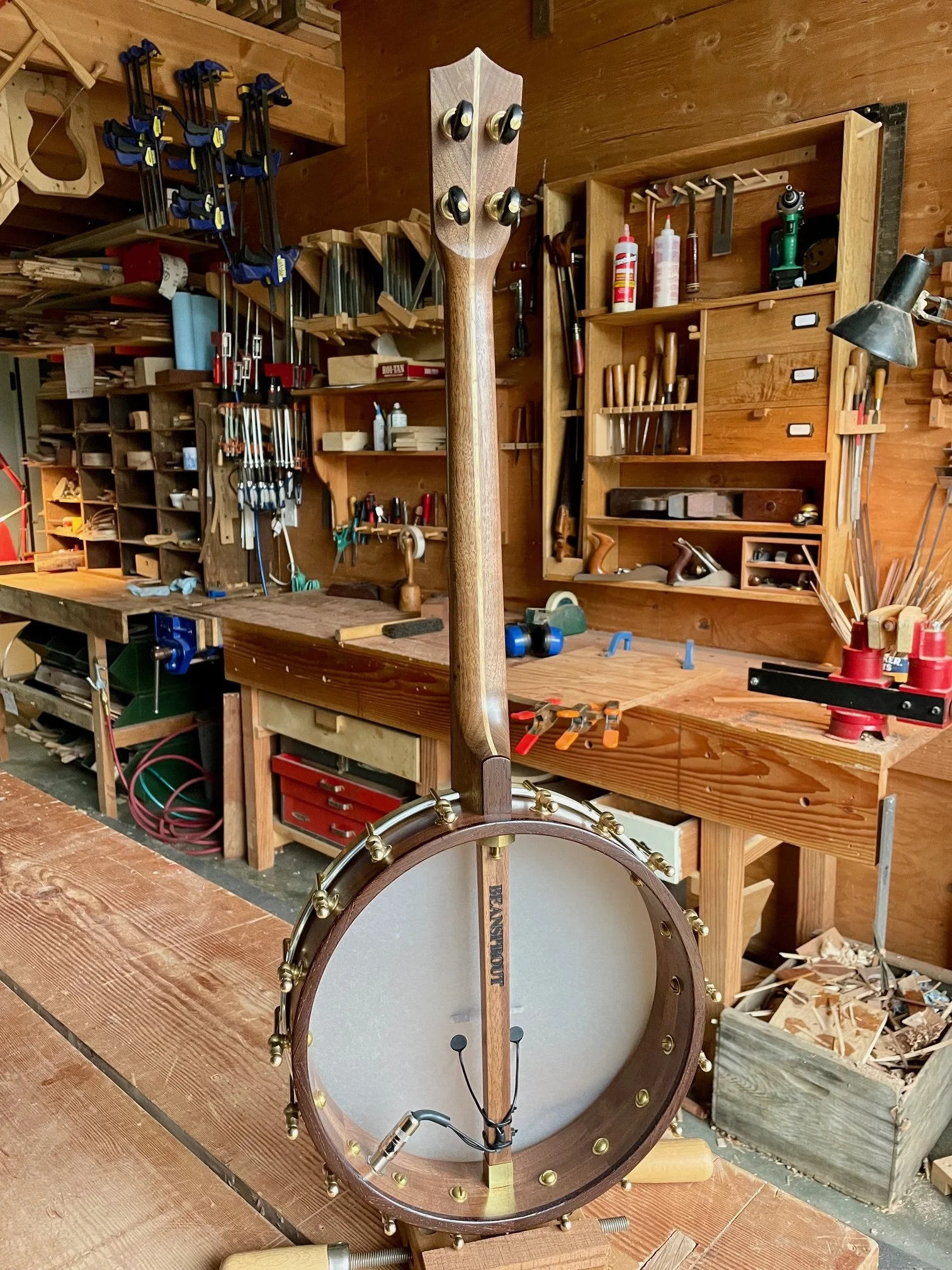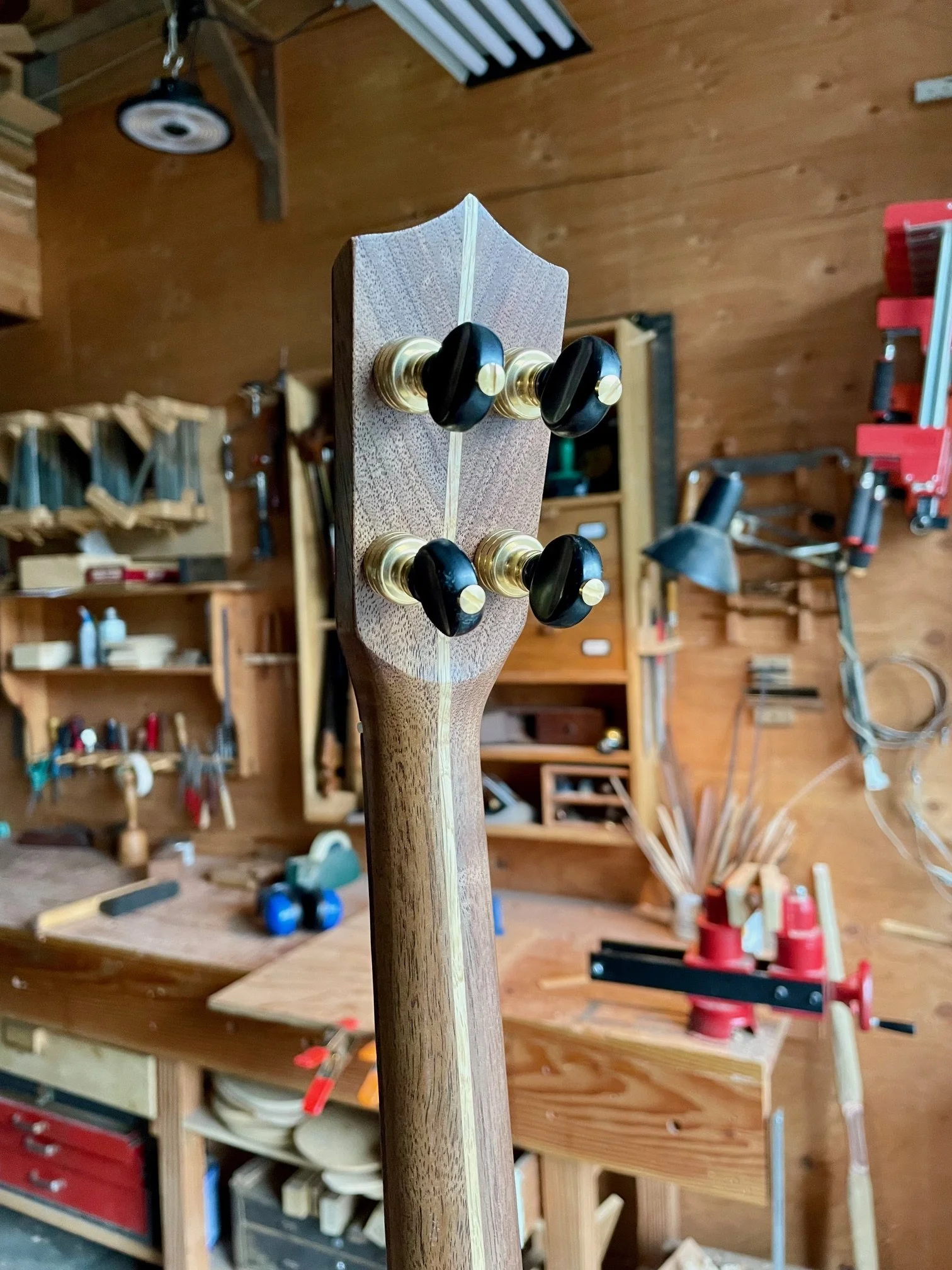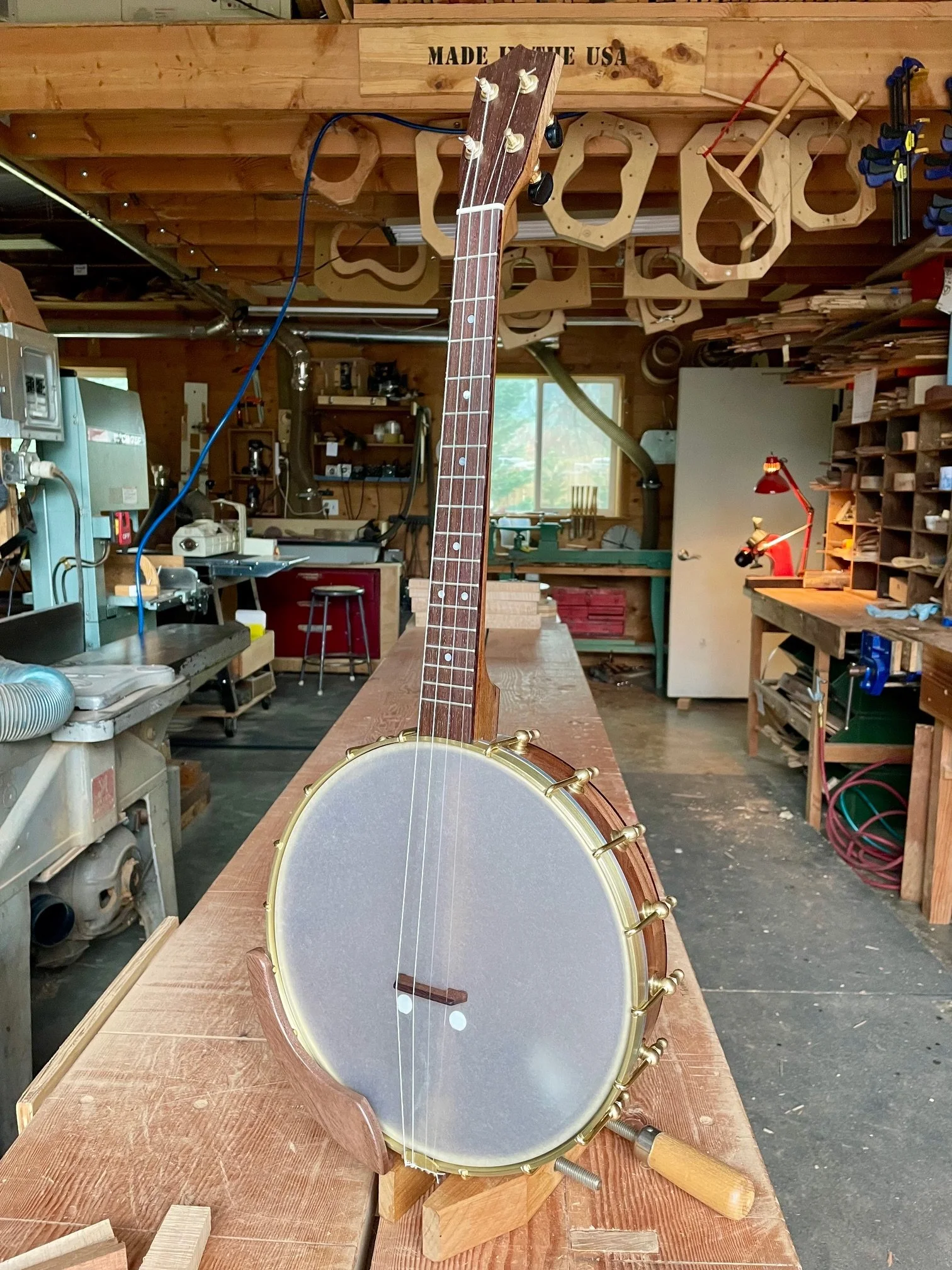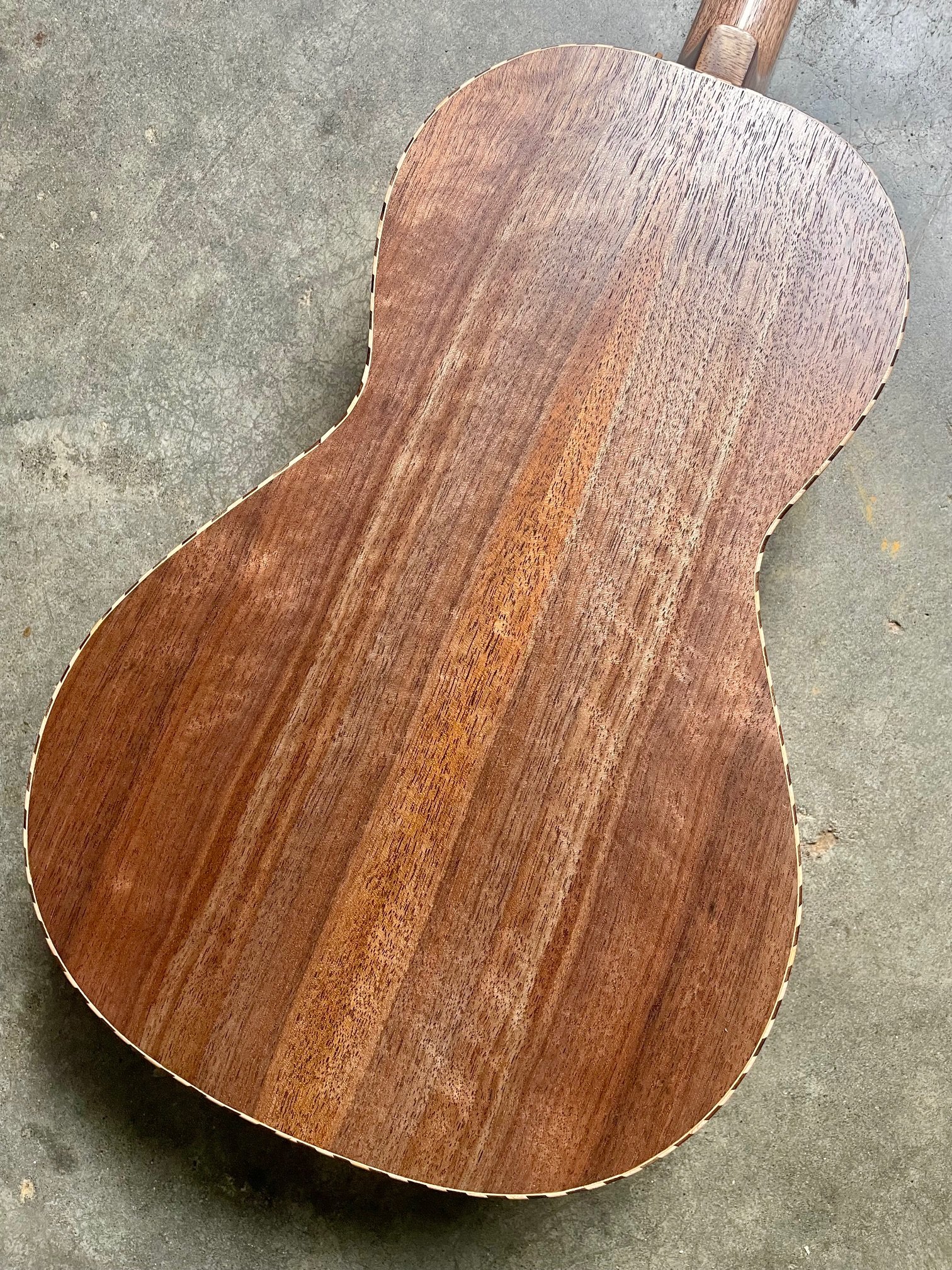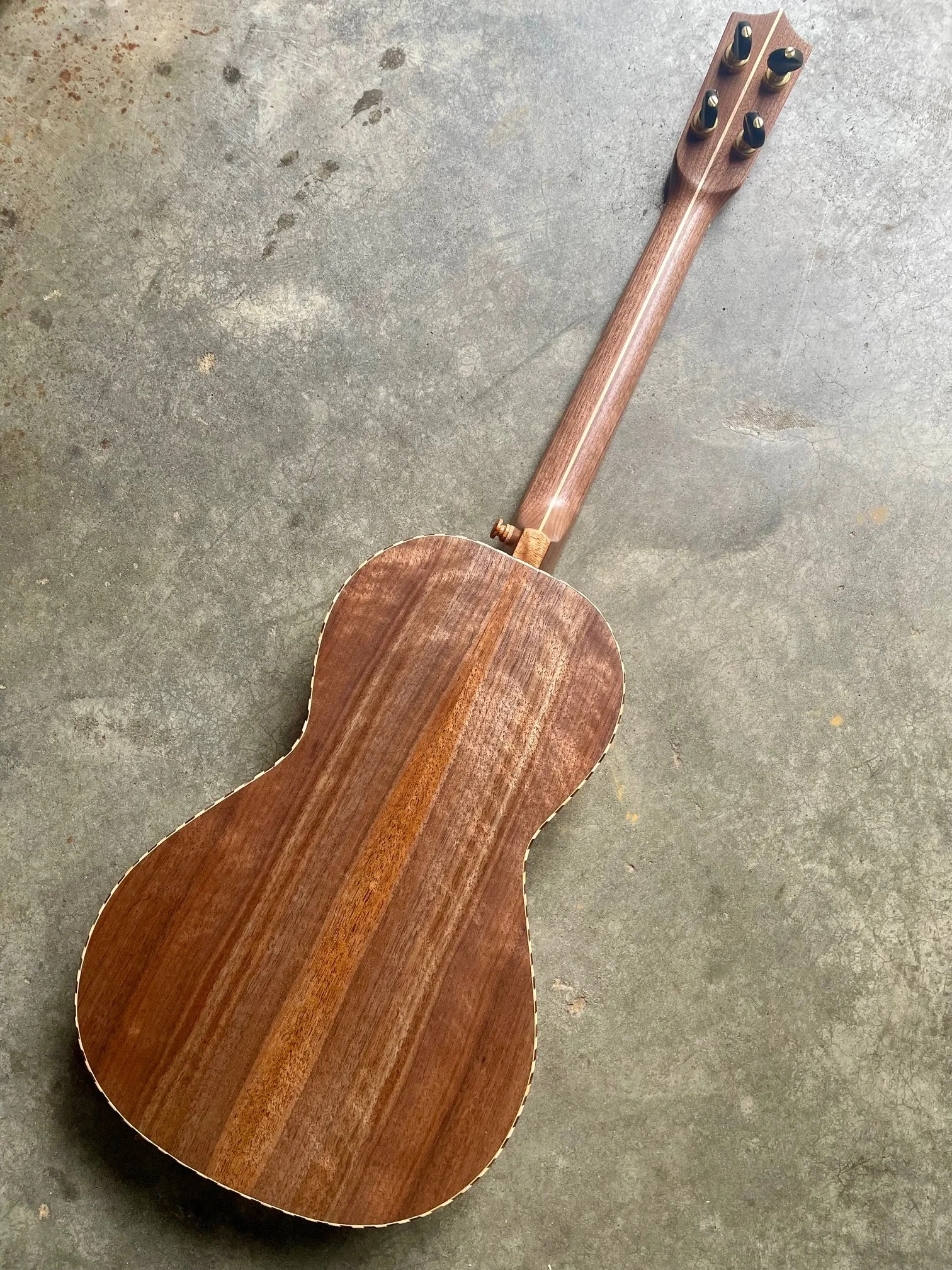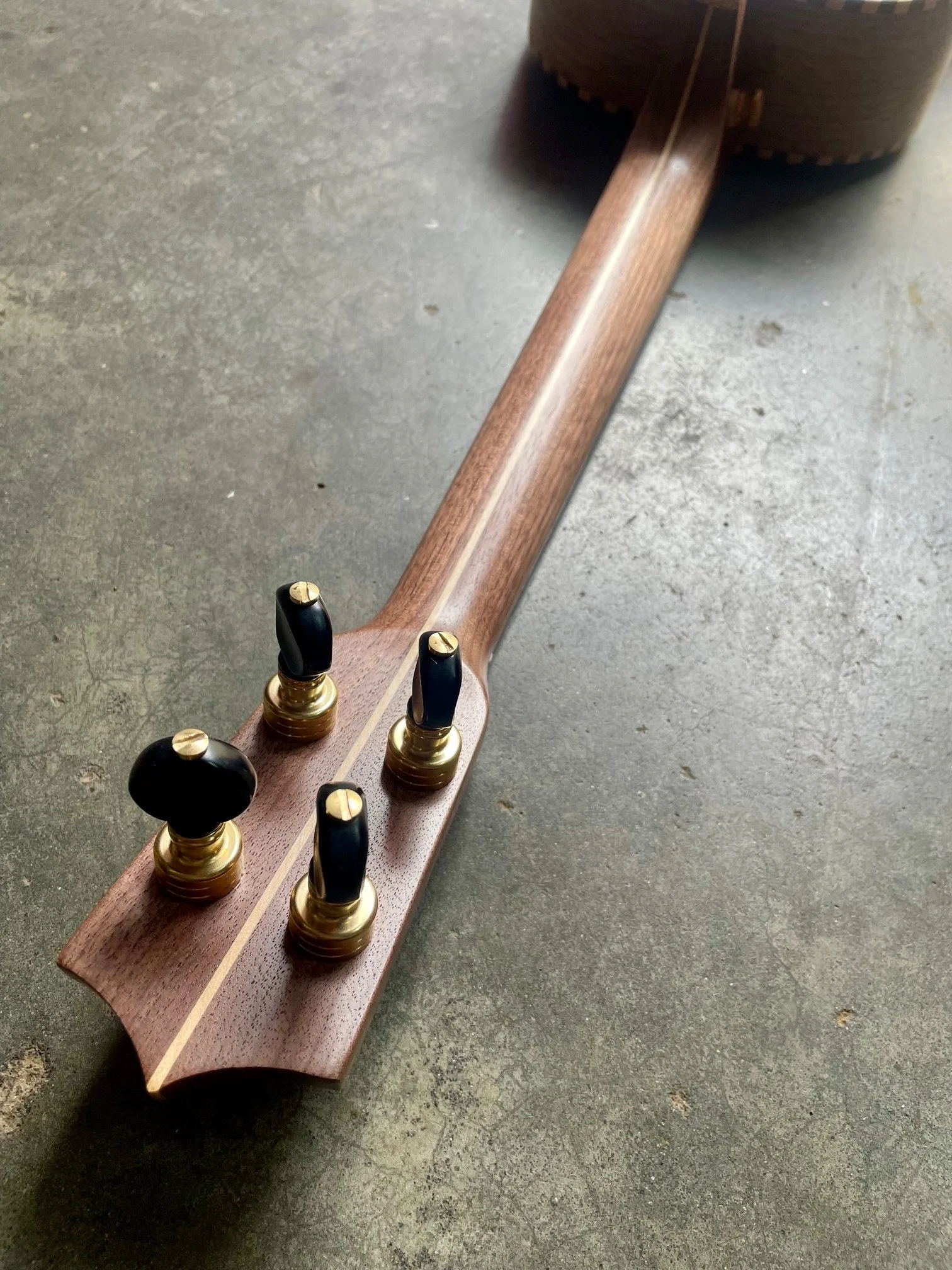This is a hybrid instrument that a few customers have asked for recently and I am well pleased with. It is a short scale tenor banjo with non steel strings. The scale length is 20”, the same as a baritone ukulele. The strings are a custom set of two wound classical guitar strings and two plain fluorocarbon, tuned CGDA. I chose some simple Walnut from Vashon Island as the main wood and some Wenge for the rest. Wenge is an imported wood that is very hard and dense, perfect for a fretboard. I only use tropical woods like the when I can salvage them, in this case from the Carpenter Ant stash in Portland. To finish it off, this banjo has a brass tone ring, Renaissance head, K&K pickup and wooden arm rest. Thanks, John!
#1008- Redwood and Walnut Tenor Guitar
This tenor guitar is for our friend Shelly, who is bravely stepping into the world of steel strings. It has a Redwood top that is a scrap from a local guitar maker. The back and sides are some Walnut from Vashon Island, WA, given to us by our friend Cath. I thought it would be plain, but it turned out to have some nice color and curl. I also chose Walnut for the neck, which I do on banjos all the time, but haven’t really done with a guitar yet. The fretboard, headplate and bridge are also matching walnut. She sent me a block of Koa that she got as a souvenir, I was able to use it for the moon inlay, engraft, heel cap and two strap buttons I turned on the lathe. The final touch is some Walnut and Maple rope binding. Have fun, Shelly!
“What the heck I said to myself. We had a performance tonight and I just packed up the tenor and gave it a test drive. The sound guy had it pretty dialed in and I loved the guitar like sound quality. I got used to the size of the neck and fret spacing right away. I even felt pretty good about the feel of the strings. It was a brave and bold move for me because I am so much a creature of habit and comfortable with my baritone.
I’m really excited to have it in my hands and can’t wait to work on a little chord melody to start. Thank you!
- S. G. ”
#1006- Cedar and Curly Walnut Alto Ukulele
This is instrument is a close copy of the ukulele I took to the Ukulele Guild of Hawaii meeting a couple of year ago. I wanted to bring something from only local woods to stand out a bit, which was fun. This customer liked the look and sound of that one, but we chose a 1.5” nut width to fit their hand better. The top is Western Red Cedar that I got from the burn pile at The Dee Mill. It was a fence line tree on an orchard in Parkdale, OR and I have never seen a cedar tree with grain like this one. The back, sides, fretboard, headplate and bridge are some curly Walnut that came from an estate sale in The Dalles, OR. I think it is loud, but well balanced, with nice sustain. Thanks Medford!
“Hello Aaron and Nicole,
I am loving #1006. I am so glad that we chose that design with those beautiful woods. I am having a hard time putting it down to perform life’s basic necessities such as eating, sleeping, brushing my teeth, etc. It sounds so sweet all the way up the neck and is such a joy to play.
Now back to practicing so that my playing will one day honor this beautiful instrument.
Thank you so much
- M. C.
”
#1005- Redwood and Koa Kingdom Era Soprano Ukulele
This instrument is part of a long term research project into the first ukuleles made in Hawaii. I researched the three Madeiran builders and the tools, techniques and materials they used to make their instruments. A few years ago I went to Hawaii to study instruments in the Bishop Museum and also met with Shawn from www.ukulelefriend.com. I then created my own models that reflected this work but used some modern features.
This ukulele has Curly Koa back, sides, fretboard and headplate, which I got from a retiring builder. The top is some Redwood, salvaged off the beach by Chris at Yodel Boy Woodworks. The neck is some Western Red Cedar. All the binding and inlay was made by me from scraps of Walnut, Maple, Myrtle and Oak. It has a radiused fretboard, geared tuners, fluorocarbon strings and a bone nut and saddle. I am very honored to get to do this work and intend to pay back the people of Hawaii when possible. Part of my profit from this uke will go to Ho’oulu ‘Aina, a nature preserve, craft school, cultural knowledge and health care non profit.
#998- Cherry and Pistachio Tenor Banjo Ukulele
I love it when a standard model suddenly seems new again! This tenor banjo uke is just sounding and playing great. It is super loud, but also sweet and a little dusty, which is thanks to the Cherry. I also think the grafted Pistachio was the right secondary wood, to give a bump to the visual interest. The Cherry is from the Carpenter Ant Stash in Portland and the Pistachio is from California orchards. Thanks Nick!
#1002- Cedar and Walnut Soprano Ukulele
I love the old soprano ukes, with the loud bark, easy portability and light weight. My goal to improve on them is to add some sustain, improve the playability and add a few modern features. In this case, a radiused fretboard, geared tuners and a pickup. The top is some salvaged Cedar from wall paneling, a common building material in the Pacific north west. The back and sides are some beautiful Walnut with light colored sap wood, that I got from Chris at Yodel Boy Woodworks. It was a tree harvested up the road in Parkdale, OR. I also used it for fretboard, headplate and bridge. Lastly, I made the neck from some salvaged Mahogany scraps, also from some wall paneling in a Portland theater. I love the sound of this Cedar top, loud and ringing, with a nice pop to the front edge and long sustain. Thanks for the order, Jason!!!
#1001- Curly Port Orford Cedar and Grafted Walnut Baritone Ukulele
All west coast woods, a unique look and a huge sound. This one is a winner! It starts with a grafted Walnut stump I got from Zena Forest Products several years ago. This was my first time milling, drying, sorting and selecting my own wood from tree to instrument and it was well worth it. I still have more of this Walnut, if someone is interested. The top is curly Port Orford Cedar from the Oregon coast, via woodfromthewest.com. The neck is some salvaged, old growth Fir from a cabinet shop. The fretboard/headplate/bridge is some beautiful Pistachio from California orchards. Thanks for the opportunity to make instruments like this!
#997- Curly Walnut and Pistachio Five String Banjo
It has been a few months since I made a big banjo, but orders seem to be picking up for next year in that world, so stay tuned. This one is made from some lightly curly Walnut and some crazy Pistachio. The Walnut is from a local tree and the Pistachio is from California Orchards. It has an 11” block rim with a brass tone ring, Renaissance head, K&K pickup and wire armrest. It has a present and focused sound, not too loud, with a nice sustain and low over tones. Thanks Tricia!!
“I received my banjo this past Wednesday and I absolutely love it! Not only is it beautiful, it sounds amazing. Please pass along my sincere appreciation to Aaron.
- T. H. ”
#994- Curly Myrtle Tenor Ukulele
This instrument is a retirement gift for Chris, who served 21 years in the Boise fire department. Thank you for all you’ve done for your community!
The all Myrtle tenor is a mainstay for us, ever since I worked at Mya-Moe and we pioneered an all domestic woods instrument. This Myrtle is from Kevin at woodfromthewest.com. It provides a balanced tone, a beautiful look and a nice feel under the hand. The neck is some Western Hemlock that I got from another luthier. The rest is Pistachio from California orchards.
“Howdy Aaron & Nicole & Henry!
Words cannot express how beautiful this uke is! It is truly a work of art and the care and craft that went into it are amazing! I really appreciate the details (like the layered endgraft!) The tone is perfect and it feels like a long-lost new friend. I will be putting in the work to deserve this for sure! I love the finish too!
The pistachio fretboard is a joy to look at (and I love the matching headplate and bridge!) The neck fits my hand so well, perfect size for me. Being a WA State native kid it means a lot to me to have this gem made out of PNW woods (and Calif. pistachio is just so pretty!)
I had bought a Fishman Micro in anticipation of this beauty and Wow! I love the K&K pickup, so clean and clear! The Kala case is so Cool too! I laughed and shouted when I opened the shipping box, “Oh man, it’s a tweed case!”
My good friend who retired from Boise FD just before me is learning guitar; I feel some jams coming on!
- C. N. ”
#991- Koa Tenor Ukulele
In some ways, this Koa ukulele is a very “normal” instrument: Koa body, Mahogany neck and the rich and zingy sound of a Koa tenor. But, some of my design ideas set it apart from the norm. First, I chose pieces for the body that are asymmetrical. Second, I used Pistachio from California orchards for the binding, fretboard, headplate and bridge. Third, the neck is made from Mahogany, which is normal, but this piece was salvaged from a retiring cabinet maker and built in the stacked style like an old classical guitar. Lastly, the rope rosette and endgraft look fresh, but traditional at the same time. I don’t use a lot of tropical woods, but when I do, they are always salvaged woods that I stumble upon. I don’t buy or import any new tropical woods for ecological, economic and human labor reasons. This Koa came to me when a local luthier moved away and literally left these boards on my porch! As always, I will donate to a Hawaiian non profit to give back to the place that grew this amazing wood.
This instrument is now available for purchase: https://www.thebeansprout.com/store/713-59g9b-7dzc3
#995- Cherry and Pistachio Mini Five String Banjo
These little banjos are so much fun for me to play! With an 8” rim and 17” scale, you wouldn’t think they could sound their best playing in the same range as the regular banjo,. but it works! (with special strings, of course). I appreciate the long sustain and slightly dusty tone that comes from the Cherry. This one is made from Cherry from the Carpenter Ant Stash in Portland and Pistachio from California Orchards. Check out the little Sprout inlay in the headstock, very cute!
“The eagle has landed!
Thank you so much, please let Aaron know I think his work is tremendous! I adore it already. Sounds amazing. So much punchier than I imagined!
It’s just a gorgeous instrument! The neck is so smooth and comfy to play. I wasn’t expecting it to be as comfy to play.
Thank you ;)
Kind regards
B. C. ”
#993- Oak and Walnut Four String Banjo
When I was growing up, my mom had an Arts & Crafts style Oak rocker. I have a lot of good memories of watching movies in the basement, sitting on that chair. This stain/finish is my attempt to recreate the look and feel of that Oak. (Maybe I will write more about the process over at my SubStack soon…)
The oak for this banjo is from Oak wine barrels from the winery up the road. I plugged all the holes with little Walnut dowels. The secondary wood is simple, local Walnut. It is an 11” rim banjo with a 20” scale, tuned gcea. It has a pickup, a goat skin head and an armrest. The final touch is a Welsh knot coin, inlaid into the headstock. Mwynhewch wneud cerddoriaeth, Rheinallt!
“Just a quick note to say that my banjo arrived safely this morning, no issues whatsoever.
The banjo is such a superb example of craftsmanship, I couldn’t be happier. Your love and passion for what you do shines through, as it has done throughout the whole process - thank you.
I’m really looking forward to getting to know my new friend.
- R. W. ”
#999- Curly Port Orford Cedar and Curly Walnut Five String Tenor Ukulele
This instrument is for Jeremy, who has #333 and #666 and now #999. It has some unusual features that I am excited to show you. It is a five string ukulele, with a high and low g in a single course. That makes it play like a regular uke, but you get the high g and low g sound. To accommodate this, I used the old headstock shape I got from a Dias instrument in the Bishop Museum. This led to using Peghed brand geared tuners to complete the old fashioned look. When I do this, I can also curve the back of the headstock, like many of the original Madeiran makers did. At the bridge, the doubled strings are held in place with a little brass pin and some shallow slots in the bridge. I saw this detail on some old taro patch ukuleles. Jeremy likes to have clear plastic pick guards on the top, which are barely noticeable unless you are up close. It has a K&K pickup, ready for the stage. For the decorative details, I made a large rope rosette and matching engraft. This compliments the star inlays in the fretboard, which came from the classic tarot card drawn by Pamela Coleman Smith in 1909. The curly top, back, sides, fretboard and headplate all come from Oregon, courtesy of woodfromthewest.com. Thanks for your continued support, Jeremy!
#990- Builder’s Choice Cedar and Curly Maple Alto Ukulele
The top of this alto uke is a piece of Western Red Cedar salvaged from some wall cladding. It is one of the best sounding ukulele top woods, although is soft to the touch and easy to scratch, which is why I added the little wooden Pistachio pick guard. The back and sides are some curly Maple from the Carpenter Ant Stash in Portland. The neck is some Cypress salvaged from a factory tank. Lastly, the rest of the instrument is some grafted Pistachio from California orchards. It is loud, bright and rich at the same time, with plenty of sustain. A very useful, all-around small ukulele.
#989- Figured Koa Scout Ukulele
These Scout ukuleles are made from shop scraps when I find the time. The waiting list keeps getting longer, so I hope to devote more time to them this winter. Usually they are rather humble, but I went a little farther this time with some special touches. The body is asymmetrical, figured Koa that I salvaged when a wood dealer moved away from my area. The neck is salvaged Mahogany from a cabinet shop. The Fretboard/headplate/bridge is some local Walnut. I was inspired by a Santo ukulele I saw in Shawn Yacavone’s collection that even had rope binding around the bridge. Even though mine isn’t that fancy, I added more rope than I would usually do on a Scout. Geared Peghed brand tuners, bone nut and saddle, fluorocarbon strings, wooden strap buttons and a nice gig bag. It goes out to the Scout waiting list today, you can join up by emailing us, info@thebeansprout.com.
#988- Curly Cherry and Curly Walnut Short Scale Banjo
I first started making these short scale banjos for smaller customers or folks who have a physical limitation. As I get older and my hands fail me, I appreciate the design even more. It still has a normal size pot, but a 20” scale and shorter neck compared to the more normal 25-26” scale. I also like the tone that comes from the Cherry block rim and non steel strings: just the right mix of punchy and warm. The lightly curly Cherry from this is from the Carpenter Ant stash in Portland. The Curly walnut for the rest of the banjo comes from a tree milled in White Salmon, WA by Chris at Yodel Boy Woodworks. It has a K&K pickup, an armrest and a sun inlay on the headstock. Thanks for the repeat business, David!
#986- Yellow Cedar and Curly Myrtle Tenor Guitar
I think I have made a dozen or so of this design and I am really settling into it. I have been trying to lean in on what makes my instruments unique instead of following others and I think it pays off. This design in particular uses a flat top, floating bridge and tailpiece. A bit strange for a tenor guitar, but normal for banjo and mandolin. I settled on this feature after studying the old Regal tenor guitars, but have worked hard to tweak it to suit modern tastes and my experience. For instance, this customer asked for GDAE, which is lower pitch and higher tension than the original was meant for. I compensate for this with a truss rod in the neck and better bracing and it pays off. All of the wood for this instrument, except for the salvaged Mahogany neck, comes from woodfromthewest.com. I believe that the yellow Cedar top is made of orphan slices from when Kevin cut a batch for a big guitar maker. (I’ll take those scraps, any day.) The mix of punch brightness and rich sustain with this top is a winner. The back and sides are curly Myrtle, the fretboard/headplate is Pistachio from California orchards and the shop made binding is Maple and Walnut.
#987- Curly Mango Alto Ukulele
Sometimes it feels good to keep it simple and let the natural beauty of the wood shine through. In this case, I wanted to feature some curly Mango that I salvaged from a piece of furniture. Mango is a tropical wood that is common as a ukulele wood in Hawaii. It is a good, medium density wood that is suitable for top back and sides. I think it is a little brighter than Koa, with a nice mid-range sound. The neck is some salvaged Mahogany and Walnut. Everything is some local Oregon Walnut that I milled. No binding, inlay or other decoration needed!!
#981- Builder’s Choice Cypress and Quilted Maple Tenor Ukulele
This is a builder’s choice instrument, made from all NW wood! The top is Leyland Cypress, which is a common fence line tree around here. It was cut from a property near here, thought to be planted around 100 years ago. The maple back and sides are scraps from our friend Paul at Arrow Guitars. I really like the black bug holes! The neck is Alder, scrap wood from a cabinet shop. The rest is local Walnut that I milled, with more bug holes! This uke is loud, bright and present. I would love to hear it in a loud jam session, floating above all of those guitars. It has fluorocarbon strings, radiused fretboard, bone nut and saddle, strap buttons and a hardshell case. Low G or a pickup (+$150) is available upon request. Price is $2100 plus shipping.
***** If you are an international customer (outside of the US), please note we may need to charge you additional shipping fees depending on your location. You will also be responsible for any customs fees imposed by your country. Thanks! ******
#983- Fir and Myrtle Kingdom Era Soprano Ukulele
This is one of my instruments inspired by my research into the first ukulele makers in Hawaii. I got a grant from Mortise & Tenon Magazine to allow me to travel to Hawaii to visit museums and collectors and try to recreate these instruments from the 1880’s. This customer wanted all of that tradition, but with a few modern upgrades, which I understand. The top and neck are old growth Douglas Fir, salvaged from an old house and the back and sides are figured Myrtle that I got from my neighbor’s shop when he retired from making flutes. The rest is Walnut from a local tree I milled. This ukulele includes geared tuners, bone nut and saddle, radiused fretboard, strap buttons and a pickup. But, the customer asked for sheep gut strings, like the originals had! It gives a warm and textured sound, with a little built in scratchiness that I like. To say thanks to the generous people of Hawaii, I will give back some of our profits to one of our favorite food/forestry/craft non profits, Ho-oulu ‘Aina.


